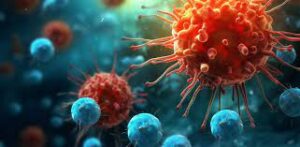December 8, 2023 – In the relentless battle against pathogens and cancer, a subgroup of white blood cells, known as Vγ9Vδ2 T cells, plays a pivotal role. Recent research spearheaded by the University of Würzburg sheds light on the sophisticated mechanism by which these immune cells identify and target their adversaries.

In the intricate realm of the immune system, Vγ9Vδ2 T cells emerge as unsung heroes, crucial in the defense against tumors and pathogenic invaders. Comprising around one to five percent of lymphocytes, a subgroup of white blood cells, these T cells exhibit the remarkable ability to multiply significantly when exposed to specific conditions. These conditions, elucidated by Thomas Herrmann, Professor of Immunogenetics at the Institute of Virology and Immunobiology, involve encounters with phosphoantigens—metabolic byproducts of pathogens that also accumulate in tumor cells or after cancer therapy.
The groundbreaking study, jointly conducted by research teams from the University of Würzburg, the University Hospital of Würzburg, as well as collaborators in Hamburg, Freiburg, Great Britain, and the USA, has unraveled new insights into the inner workings of Vγ9Vδ2 T cells. The findings, published in the prestigious journal Nature Communications, underscore the critical role these immune warriors play in controlling infections and combating tumors.
Herrmann explains, “Vγ9Vδ2 T cells are therefore crucial for the control of infections and tumors,” emphasizing the significance of these cells in maintaining the body’s immune balance. The research delves into the molecular intricacies that enable these T cells to discern the presence of threats, paving the way for potential advancements in clinical applications.
Continue to Part 2 for a deeper exploration of the molecular interactions and potential therapeutic implications.
Part 2: Decoding the Dance of Molecules: Vγ9Vδ2 T Cells and their Molecular Interactions
In the pursuit of understanding how immune cells recognize and combat threats, the recent study led by Professor Thomas Herrmann and Dr. Mohindar Karunakaran at Julius-Maximilians-Universität Würzburg (JMU) has unveiled a fascinating dance of molecules within our cells.
The key revelation centers around phosphoantigens, metabolic products of pathogens, which bind to BTN3A1 molecules within cells. This binding leads to the formation of molecular complexes, recognized by receptors on the surface of Vγ9Vδ2 T cells, ultimately triggering the signal for these immune cells to eliminate the identified threat.
However, the complexity of this interaction extends beyond the primary players. It was discovered that certain relatives of the BTN3A1 molecules, even those not binding phosphoantigens, are essential for signaling the immune cells to initiate their attack. The research teams have diligently identified specific areas of these molecules that are crucial for this intricate molecular dialogue.
Professor Herrmann envisions the clinical implications of these findings, stating, “These findings can improve the clinical use of Vγ9Vδ2 T cells in the fight against tumors.” The prospect of developing drugs that enhance the interaction between phosphoantigens, BTN molecules, and Vγ9Vδ2 T cells opens new avenues for therapeutic strategies.
However, the scientific journey is far from complete. Further analyses are warranted to comprehensively understand the interplay between BTN molecules and the receptors of Vγ9Vδ2 T cells. As the exploration continues, intriguing additional functions of BTN molecules emerge, including their role in preventing infections, such as resistance to the bird flu virus, and their ability to influence the fight against tumors by conventional T lymphocytes.
In upcoming studies, scientists aspire to unravel whether distinct areas of BTN molecules mediate these diverse functions and whether these molecules can be selectively manipulated for therapeutic purposes. The ongoing quest to decode the intricate language of immune cells holds promise for advancing our ability to harness the power of the immune system in the fight against diseases.